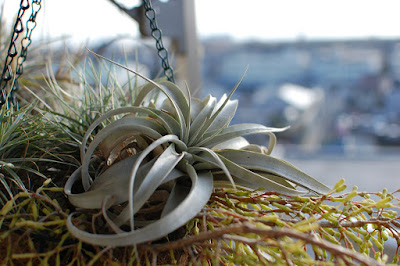Tillandsia xerographica is native to the semi-arid zones of Mexico, El Salvador, Guatemala and Honduras. It is found in very dry woods, where it grows as epiphyte on trees or as a lithophyte at 140-600 meters in height...
Tillandsia xerographica, also called as The King of Air Plants, is a species of the genus Tillandsia. Several synonyms are know for this species such as: Tillandsia kruseana, Tillandsia xerographica f. variegate, Tillandsia tomasellii. This airplants species was described by Otto Rohweder in 1953.
IDENTIFY TILLANDSIA XEROGRAPHICA
Tillandsia xerographica is native to the semi-arid zones of Mexico, El Salvador, Guatemala and Honduras. It is found in very dry woods, where it grows as epiphyte on trees or as a lithophyte at 140-600 meters in height.
It is a fairly large species, slow-growing, xerophytic epiphyte, which forms a rosette of 20-60 cm in height and 50-90 cm in diameter and can be used from 12 to 18 years to go from seed to maturity when growing in nature; but in cultivation with artificial conditions, with the use of fertilizers and hormones, they are generally much smaller and the time is reduced to about 6-8 years.
The King of Air Plants blooms from the inflorescence, on a thick, green stem, from 6 to 15 inches in height, densely branched. The leaf bracts are rosy red; the floral bracts are chartreuse; and the petals of the tubular flowers are red to purple and are very long lasting.
TILLANDSIA XEROGRAPHICA CARE
Cultural information should only be used as a guide, and should be to be adapted to suit you. Your physical location; where you grow your plants, how much time you have to devote to their care, and many other factors, will need to be taken into account. Only then can you decide on the cultural methods that best suit you and your plants.
Light and placement:
Tillandsia xerographica needs a very bright position and a long enough photoperiod, with 10 hours of light a day at a minimum. Beware of direct sunlight, especially in hot weather, because its leaves will burn very easily. During the summer it can be outdoors, as night temperatures do not fall below 16-18 ° C: in its natural habitat temperatures range between 20 and 28 ° C. In this case you choose a bright place, protected from direct sunlight and rains.
Mounting:
Tillandsia xerographica refer to be mounted on a solid substrate that does not retain water. You can glue the plant directly to the surface with a strong adhesive, or you can wire the plant to the base. Don't cover the base of the plant with moss or it may rot. It can be grown on almost any imaginable decorative mount, including shells, rocks, slate, driftwood, etc. Group them in decorative clumps for maximum effect.
Watering and humidity:
Tillandsia xerographica does not like excess water, so it is only slightly waterings every day in summer and every 3-4 days in winter. The air humidity must be at least close to 60% (in nature it is 60-72%). If the air is drier, waterings must be more abundant to compensate for the lack of moisture in the air. In nature after a rain, the plant briefly accumulates water in the axil of the leaves, but in cultivation, especially when it is not possible to guarantee good movement of the air around the plant, it is better to avoid such accumulation, as it could cause rosette rot.
Fertilization:
Fertilizing is not absolutely necessary to survival, but will increase the growth and vigor of your plants and their blooms. This species need a fertilizer that can be absorbed directly in to the plant via the leaves and use Bromeliad fertilizer (17-8-22) twice a month is recommended.
Reproduction:
After flowering, Tillandsia xerographica pass from 5 to 12 months before the plant begins to produce pups, and to do so it must be treated well: the plants that are neglected after finishing the flowering die without making the pups. If everything proceeds correctly, the mother plant produces the pups (from 1 to 3) and deteriorates over a period of 3-4 years. Young plants can be separated from the mother plant when they are about ½ of the parent's size, and will mature in about one year.















COMMENTS